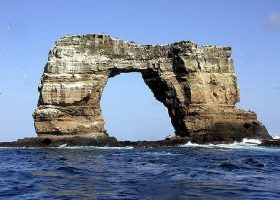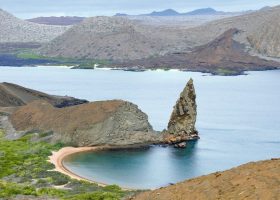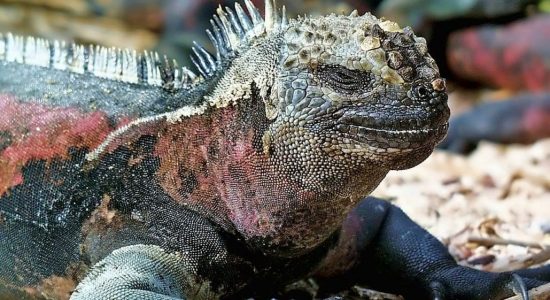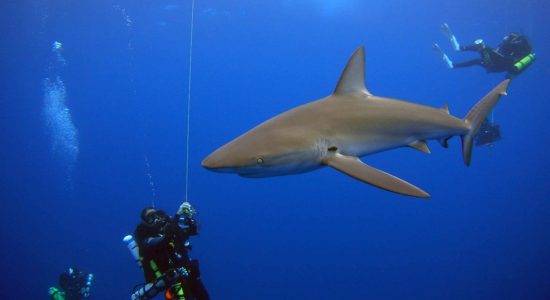Bienvenidos - Welcome!
When we talk about scuba diving in Ecuador, the Star is GALAPAGOS ISLANDS. In 1979, the Galapagos Islands became the world’s first UNESCO-designated World Heritage Site — an honor bestowed upon our planet’s most magnificent places. Following a few simple rules is all it takes to experience the magnificence of the Islands in a sustainable way. From respecting the wildlife to purchasing souvenirs wisely, your choices will make a difference. Please review the Galapagos National Park rules before you travel to the Islands.
Info source by galapagos.org
Best time to dive?
Since the wet and dry seasons fade in and out each year, there’s never a bad time to dive; from June to December (“the busy season”) temperatures and the Antarctic Humboldt Current tend to keep the seawater a bit chillier, so cold-water dive equipment is recommended for exposure protection; many divers have found that the January to May off-season hosts more comfortable, warmer water temperatures for deep diving, but you should still bring adequate gear for cold-water dives. Info source by galapagosisland.net
Best time to Dive?
Since the wet and dry seasons fade in and out each year, there’s never a bad time to dive; from June to December (“the busy season”) temperatures and the Antarctic Humboldt Current tend to keep the seawater a bit chillier, so cold-water dive equipment is recommended for exposure protection; many divers have found that the January to May off-season hosts more comfortable, warmer water temperatures for deep diving, but you should still bring adequate gear for cold-water dives. Info source by galapagosisland.net
- {{ listingType.name }}
- prev
- next
Do you offer Diving services?
Promote your services and connect with divers
Are you a Scuba diver?
Join and get the best benefits for your next trip
Do you offer Diving services?
Promote your services and connect with divers
Are you a Scuba diver?
Join and get the best benefits for your next trip
Sea Life
The marine life of the Galapagos is even more outstanding than what is to be found on land. The fish biomass here is on average 17.5 tons per hectare,
the largest of the world. A vast array of marine creatures thrives with life. Galapagos Scuba diving and snorkeling is fulfilled
with sea lions, penguins, seals, eagle rays, marine iguanas, hammerhead sharks, Galapagos sharks, sea turtles, golden rays, whale sharks and more.
Amazing creatures such as Marine Iguanas can be seen feeding and swimming a few meters from you. Sea lions are the most playful creatures of the islands that enjoy blowing bubbles and even pulling your fins when snorkeling at almost any location. Many fish species are always forming part of the underwater scenario: snapper, angelfish, butterfly fish, surgeonfish, water jacks, barracudas, grunts, rays and sharks. There are about 86 species of fish endemic to the Galapagos. Some of the most common are Camotillo, Galapagos Blenny, Galapagos puffer, Galapagos Drum, Galapagos Garden Eel, Yellow Tailed Damselfish.
Info source by gogalapagos.com
Dive Sites
Although you don’t need to be an expert to dive in the Galapagos, the more skill you come with will make for a more enriching experience. Most companies say at least 20 logged dives should be a starting point for diving in the Galapagos. There are several places for beginners to start with the basics on the Islands, but it’s a good idea to get practice and certification before coming to the Galapagos so you can take advantage of every reef the Islands have to offer. The best way to experience all that diving has to offer in the Galapagos is to book a live-aboard trip. If you want to mix in some land-based adventures, however, consider booking with a hotel that offers diving cruises and coordination services. Dive sites Info Source by galapagosisland.net












Darwin Island
Just out of range of the Humboldt Current in the northwest corner of the Islands, warm water species enjoy this marine environment of the Galapagos. Keep your eyes open for parrotfish, angelfish, surgeonfish, and trumpetfish. Of course, there are scores of species that call this warm-water reef home, including the barracuda, hammerhead sharks, sea turtles, a variety of ray species, and whale sharks (if you visit between June and October). Dive coordinators will take you into the famous formations known as El Arco (The Darwin Arch) and El Arenal (The Darwin Theater), both of which are phenomenal spots to lock your grip onto the rock wall and be astounded by the passing iris of wonders the Galapagos have to offer.
Wolf Island
Many miles northwest of San Cristobal Island is a triangular island that will remind you why diving is your passion. With three distinctive dive sites – Shark Bay, Landslide, and The Caves – the countless species you will encounter here will leave you speechless. Between choppy waters, strong currents, and jagged rocks, this is not a site for beginners. But if you have adequate experience, then there’s really nothing you can’t see here: sea lions, turtles, all manner of sharks (Galapagos, silky, hammerhead and the elusive whale shark), rays (eagle, sting, manta, and mobula), and even the friendly bottlenose dolphin.
Gordon’s Rock
Right in the heart of the central Galapagos Islands is one of the most vivid underwater scenes you will find anywhere, nested in the eroded crater atop a tuff cone. Despite strong surges and “washing machine conditions” near the surface, this site is notable for its flourishing sea life. Witness scores of hammerheads patrolling the area, alongside eagle and manta rays. Other Galapagos shark species frequent the area as well, and swim in company with turtles, mobula rays, eels, and barracuda, in addition to a rainbow of other schools of tropical fish.
Punta Vincente Roca
This is one of the more unique dive sites in the Galapagos, situated off the northeastern coast of Isabela Island, but be warned: it is also one of the coldest. If you’re diving here, you should be in your full-body 7mm wetsuit with your hood. Once you get past the initial shock of the chilly waters, though, it’s absolutely worth it, as you’ll see all manner of exceptional creatures, like the Mola (Ocean sunfish) which has been described as a “large floating head with fins.” Turn your back to the rock, and you’re likely to see the rare Galapagos bullhead shark (horn shark) and maybe even sea horses, penguins, and sea lions going for a nice chilly dip.
Roca Redonda
Just like Punta Vincente Roca, this Isabela Island dive site is not for heat-seekers and will require full exposure protection suit, including your hood, to keep warm. Although it has stronger currents and surge that require you to pay closer attention to buoyancy control as you enter and dive through the shallows, it is truly worth it as one of the more active dive sites of the Islands. It’s like you’re plunging into your own tropical aquarium: famous for its fumaroles (streams of natural gas bubbles) Roca Redonda constantly reminds you that the islands were formed by millions of years of volcanic activity.
Punta Carrion
Right between Baltra and Santa Cruz Island, Punta Carrion is a great spot to ease into your diving adventure. The most interesting sea life you will find here is between 12m and 18m (40’-60’); it includes creole fish, blue striped sea slugs, and sea lions. If you turn to the great blue yonder, you will probably see passing mobula rays and the ever-so-common reef and hammerhead sharks that frequent most dive spots in the Galapagos.
How to Arrive
Many visitors will travel to Galapagos by air from mainland Ecuador. Flights depart daily from the principal cities of Guayaquil or Quito (direct or via Guayaquil). Three companies currently offer flights: TAME, LAN-Ecuador, and Avianca.
There are two main airports in Galapagos, one on Baltra Island and the other on San Cristóbal. At the airport in mainland Ecuador before checking in, you will be required to have your bags inspected by the Galapagos Biosecurity Agency quarantine staff and obtain a mandatory $20 tourist transit card. Upon arrival in Galapagos, you will have to pay an entrance fee in cash to the Galapagos National Park (currently $100 for non-Ecuadorian adults and $50 for children). Returning to the US or other international destination from Galapagos generally requires an overnight stay in either Quito or Guayaquil. Info Source by galapagos.org

